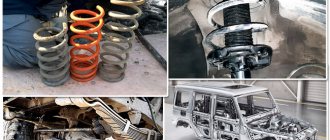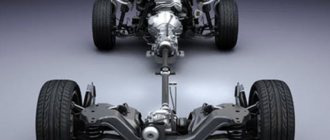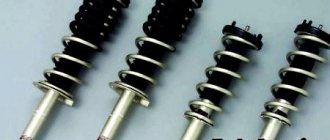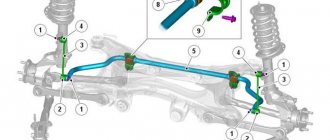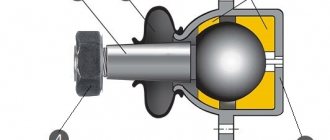19.07.2019
| (No votes) |
Issues discussed in the material:
- How the rear suspension works
- What types of rear suspensions are there?
- What are the typical rear suspension problems?
- How to understand that your car's rear suspension needs repairs
- How to repair rear suspension
A car suspension is not only needed to ensure comfort while driving, but also affects the handling of the car. It is very important to perform timely maintenance and repair of your vehicle's rear suspension. The suspension of the front axle of the car is no less important. Every driver should know the structure of a car suspension, especially those components that most often fail.
Purpose and design
A vehicle's suspension performs several functions. Basic:
- ensuring elastic fastening of the wheel to the body
- vibration damping
- ensuring contact between the wheel and the road surface
It was invented at the same time as cars. She is as old as the first car released from production. At the same time, it has still not been possible to create an optimal suspension that would suit any car.
Despite the varieties, the products are similar to each other in their components. The design contains:
- Elastic elements - leaf springs, springs, etc. Their main task is to absorb the loads received when the wheel hits the chassis.
- Damping elements or shock absorbers. They dampen vibrations received from elastic elements through absorption and dissipation of vibration waves. That’s why they are usually installed next to elastic elements.
- Guiding systems. Designed to connect the wheel with the supporting part, which ensures the ability of the machine to move along the desired trajectory. This group includes levers, rods, beams.
All components perform a number of specific functions, and even without one element it does not constitute a single structure.
What is it for?
An important part of the chassis - the rear suspension - levels out road irregularities, creates a smooth ride, increasing the comfort for the driver and passengers when traveling.
The design also implements a number of other functions:
- physically forms the connection between the wheel (unsprung mass) and the frame or body (sprung mass);
- resists skidding and rollover of the car when cornering;
- additionally participates in inhibition.
By performing the above tasks, the rear suspension contributes to better vehicle cross-country ability.
Dependent suspension
The very first suspension produced and used on cars. It is she who is considered the longest-liver among existing structures. And the prototype for creation was a horse-drawn carriage.
A special feature is the reliable connection of the wheels, preventing the parts from moving relative to each other. The rear axle acts as the connecting axis. Elastic elements are springs, although not so long ago they were springs. The damping element is a shock absorber. Install it in two ways:
- Separate from the springs.
- On the same axis as them. This arrangement requires installation inside the spring.
The shock absorber is mounted from above to the body, from below - to the bridge. The shock absorber has two functions - one involves damping vibrations, the second - secures the wheels to the axle.
Levers and rods, located in the transverse and longitudinal directions respectively, are the components of the guide system. There are four of them in total. They make sure that the movement of the axle and wheels is predictable. The transverse link serves to reduce the roll angle when the car turns while it is moving. Pros:
- simple execution;
- reliability;
- ensuring high-quality grip.
The main disadvantage is the loss of traction between the wheels and the road if the car enters a turn. This can be very dangerous. Today they are not in demand, and they try not to use them. Mainly found on trucks.
Common car rear suspension problems
All automakers today strive to make the suspension of their cars as comfortable and reliable as possible. Moreover, cars produced for the Russian market are equipped with a reinforced suspension option. This strengthening is achieved by increasing the ground clearance and using stiffer springs. But operation on domestic roads sooner or later causes malfunctions even in the reinforced chassis, which puts the car owner in front of the need for repairs.
We list the main problems that arise in the suspension design:
- violation of wheel alignment (wheel alignment angles);
- deformation of suspension arms;
- weakening or destruction of springs;
- various damage to the shock absorber;
- wear of the shock absorber support;
- bushing wear or damage to the anti-roll bar;
- Damage to rubber-metal or ball suspension mounting elements.
The main reason for suspension wear is the poor quality of roads. However, there are other factors that affect the durability of chassis parts. For example, driving style and skill, especially when driving over bumps. The qualifications of car service technicians servicing suspensions are important. And also a lot depends on the quality of the components used during repairs.
Suspension problems occur either gradually or all at once. This happens when driving over bumps and obstacles. Ignoring some faults may lead to the failure of other parts, since everything in the suspension is interconnected.
The car owner can understand from indirect signs that problems are starting in the suspension. Let's list these signs:
- the car does not keep the road (trying to go to the side);
- turning and braking are accompanied by rocking of the car body;
- the movement of the car is accompanied by vibration;
- suspension knocks while driving;
- “breakdowns” or increased rigidity when driving over uneven surfaces;
- tires wear quickly or unevenly.
However, you should know that similar symptoms are also typical for steering problems. Therefore, it is possible to specifically determine which component of the car needs repair only after a thorough inspection and check of all suspension elements.
The above symptoms may not be caused by malfunctions in the suspension, but by violations of the nominal operating parameters of the wheels. For example, with underinflated tires, the car may not hold the road and veer to the side. Vibration is also caused by insufficient air pressure in the tires. If the wheel is not balanced, then beating and knocking in the suspension is expected when driving. Therefore, when diagnosing the condition of the suspension, first of all, versions associated with a discrepancy in the operating parameters of the wheels are excluded.
Some motorists ignore faults and drive a car with a faulty suspension. But it is strictly not recommended to do this, since any malfunction in the chassis can cause an accident.
We systematize in the table suspension malfunctions and the signs that indicate them:
| Signs | Malfunctions |
| Pull to the side when driving | Front wheel alignment violation; violation of the geometry of the suspension arms; loss of spring stiffness; damage to the upper shock absorber support; failure of the anti-roll bar. |
| Rocking when turning and braking | Poor quality shock absorber; deterioration of bushings or breakdown of the anti-roll bar. |
| Vibration while moving | violation of the angle of installation of the front wheels; the shock absorber has lost its characteristics. |
| Knock when driving | Spring breakage; shock absorber malfunction; Rubber-metal or ball suspension elements require replacement |
| "Breakdown" of the suspension | Deformation of the suspension arm; reduction in spring stiffness; shock absorber malfunction; Rubber-metal or ball suspension elements require replacement. |
| Uneven or increased tire wear | Violation of the alignment angle of the front wheels; deformation of the suspension arm; Rubber-metal or ball suspension elements require replacement |
Independent
The difference between this suspension and others, as you might guess, is the lack of connection between the wheels, which are on the same axis and located parallel to each other. This way, if for some reason the position of one wheel changes, it will not be reflected in the other.
They are divided into several types, and each of them deserves special attention.
DIY car rear and front suspension repair
It is quite possible to repair the rear suspension yourself. The process is quite labor-intensive, but does not require special skills and knowledge.
You just need to acquire the following tools:
- jacks;
- lift or pit;
- set of hexagons;
- open-end wrenches and sockets;
- hammer;
- puller;
- spring ties;
- penetrating lubricant type VD-40;
- Litol lubricant;
- grinder - in some cases you can’t do without it.
With this set of tools, you can safely begin repairing the rear suspension yourself.
The front wheels of passenger cars are usually equipped with independent suspension. Comfort of movement in this case is excellent, because each wheel is securely connected to the road.
But the rear suspension is dependent, the wheels are connected by a beam. That is, the vibrations of one wheel are transmitted to the other, reducing its grip on the road surface.
You can determine the serviceability of shock absorbers and springs by pressing and releasing a corner of the car body. A working shock absorber should return the body to its original position without vibration. If vibrations occur, the shock absorber, spring, upper and lower strut mounts must be carefully inspected. Visually assess the geometry of the rear wheels. If their angles are not the same or the wheels are located at different heights from the body, this indicates a defect in the beam that needs to be replaced.
Driving on a bad road with potholes is accompanied by a knocking sound in the suspension.
Knocks appear due to wear and aging of silent blocks. The result of destructive processes is the appearance of gaps in silent blocks, play of the beam and lever relative to each other. If the movement of the car is accompanied by an unusual hum in the wheel, you need to check the wheel bearing play.
We will describe the procedure for replacing the rear shock absorber. Beforehand, a few hours before work, it’s a good idea to treat all bolted joints with VD-40 lubricant. If the shock absorber is located inside a spring, to replace it you need to compress the spring. This is done using a spring tie. Unscrew the shock absorber fastening to the suspension. If the nuts are stuck, use key amplifiers or heating the bolted joints. After unscrewing the nuts, remove the bolts from the eyes and remove the faulty shock absorber.
Installing a new shock absorber is done in the reverse order. To align the lower shock absorber mount with the eye in the suspension, you need to lift the car with a jack. All nuts must be tightened with a torque wrench, observing the tightening torque given in the vehicle's operating manual.
We recommend
“A dent on the threshold of a car is not a death sentence, but only an annoying nuisance” Read more
MacPherson struts
Many people know this type as a “swinging candle.” The main difference is the presence of a shock-absorbing strut, which performs several functions at once. In this case, all functions are performed simultaneously. The design involves:
- shock absorber;
- spring.
The element is attached to the wheel hub from below, and to the body from above. In the second case, additional supports are also used. Thanks to this type of fastening, it is possible to ensure reliable fixation of the wheel with the body when rocking. There is also a guiding system. Its role is played by levers having a transverse direction.
The stand is the most popular and in demand type. Its purpose is to ensure comfortable movement on the road. The suspension is valued for its reliability and durability.
Principle of operation
Car suspension works as follows:
- When the car hits an obstacle, the wheel rises above the horizontal track, changing the position of the rods, levers, and swivel units.
- The shock absorber immediately comes into action. At the same time, the spring, which was previously in a free state, is compressed under the influence of the kinetic energy of the tire push in the direction from the plane of the ground - upward.
- The elastic compression of a shock absorber with a spring displaces the rod: rubber-metal bushings partially absorb shocks and vibrations transmitted to the car body.
- Then a natural reverse process occurs. A newly compressed spring always tends to straighten out and return the shock absorber, and with it the wheel, to its original position.
The cycle is repeated with all wheels.
Lever
The lever type is also a representative of an independent type of suspension. A fairly well-known option, which has two types of design:
- Double lever. The shock absorber strut is used only to dampen vibrations. Fastening is carried out by a control system, which includes two transverse arms with an A-shaped design. The part prevents unnecessary movement of the wheel when driving. However, in comparison, the MacPherson strut is softer and easier to control.
- Multi-link. Improved double-lever design. Two levers are complemented by eight more similar parts. Due to this, it was possible to improve the smoothness and comfortable driving.
Basically, preference is given to MacPherson struts and a double-lever design. They are found in most vehicles and are especially popular among modern and expensive models. Also preferable for installation in cars with soft suspensions.
Checking the condition of the vehicle's rear suspension
To extend the life of your car's rear suspension, you need to follow certain rules. Every 20 thousand kilometers it is necessary to inspect the suspension. It is recommended to carry out an extraordinary check every time after hitting a large obstacle or falling into a hole.
Detailed instructions have been developed to help the car owner independently diagnose the condition of the suspension:
- Raise the rear of the car using a lift or jacks. Then, while rotating the rear wheel by hand, listen to see if it makes any extraneous sounds when rotating. See how easily the wheel rotates.
- Using pressure from below and above, swing the wheel vertically. Listen carefully to see if the movement of the wheel is accompanied by a knock, or if there are any backlashes. If these phenomena are present, it is necessary to repeat the operation with the brake pedal held down. You'll need an assistant here. If the knocking stops, it is highly likely that the problem is the wheel bearing. Otherwise, you need to continue diagnostics.
- Insert a screwdriver between the steering knuckle and the lever. The presence of play indicates the need to replace the ball joint. If only the cover is damaged, you can get by by replacing it.
- Using a screwdriver or small pry bar, move the eye by inserting the tool between the lever and the subframe. If it moves easily, the silent block of the lever has exhausted its service life and needs to be replaced.
- Moving the ball joints, assess the presence of play. If play is detected, the ball joint struts must be replaced. Inspect the covers of the ball joints and steering gear. There should be no cracks or other damage. Inspect the shock absorber for oil leaks. Leaks indicate the need to replace the shock absorber. Inspect the bushings, springs and motion buffer.
We recommend
“Checking current leakage in a car: step-by-step instructions” Read more
Semi-dependent
This type of pendants is something in between the options described above. In appearance, the design resembles a dependent suspension. It also has a beam and trailing arms, thanks to which it is possible to connect two wheels located on the same axis.
The semi-independent suspension is secured using levers. Elastic and damping elements are the familiar springs and shock absorbers, respectively.
But the semi-independent beam is torsion bar, which allows it to also work in torsion. Thus, the wheels can move in a vertical direction independently of each other.
Pros:
- simplicity;
- reliability.
Often found on rear-wheel drive cars.
Types
The various variations of rear suspensions can, however, be divided into three main types:
- Dependent design. A pair of rear wheels is rigidly connected by an axle, a beam, or a split or continuous axle. Often there are combinations of suspensions that provide for the installation of an axle with a spring (dependent, spring), a spring (dependent, spring) and pneumatic elements (pneumatic, dependent). When the wheels are connected by a rigid beam, the load is directly transferred from one side to the other: then the ride is no different in softness.
- Semi-independent suspension. The same beam is used here, but with the characteristics of a torsion bar. Or the latter is built into the beam. This design feature adds smoothness, as the torsion bar softens the stress transmitted from one slope to another.
- Independent type. The wheels connected by an axle cope with the loads independently. Independent suspensions are pneumatic and torsion bar.
The third version of the mechanisms is the most progressive, but complex and expensive.
Hydraulic
Hydraulic suspension has a number of features. The main one is the modified shock absorbers. Unlike standard shock absorbers, conical shaped parts filled with oil are used. Additionally, each part is equipped with a spherical hydraulic accumulator.
Among the advantages:
- durability;
- smooth ride under all conditions;
- possibility of adjusting the ride height remotely.
They are strong and quite reliable. However, the downside is the presence of oil in the design. The fact is that if an oil leak occurs, not only the product will fail, but also the brake system and power steering.
Car beam replacement
It is necessary to raise the rear of the car, securely blocking the front wheels. Then remove the rear wheels. Disconnect the shock absorbers and springs from the beam. Release the beam from the hand brake cable. The brake system lines are also partially disassembled, disconnecting them from the hose tip. At this point, brake fluid may begin to leak from the system. To prevent this undesirable phenomenon, you need to plug the brake hoses using any available means. For example, brake bleeder caps work well.
Next, unscrew the bolted connections securing the beam to the body and dismantle the beam. Installation of the new part is carried out in the reverse order. The only caveat is that after lowering the car onto the wheels, you must once again tighten the bolted joints securing the beam to the car body.
Screw
Helical suspension is a general name for several types of suspensions, the design of which provides the ability to regulate the degree of spring pretension. The advantages of this design are:
- ease of maintenance;
- strength;
- durability;
- good job for Russia.
She is tough and almost indestructible. If it breaks, you can fix it yourself. At the same time, manufacturers recommend inspecting the structure as often as possible. To avoid frequent breakdowns, you can lubricate the surface of screw-shaped shock absorbers with a special lubricant.
Which one is better to choose?
It all depends on how full your pocket is and the operating conditions of the car.
For civilian cars in the mid-price segment, a torsion beam in the rear suspension is preferable . It is not demanding to maintain and is not expensive to repair. For everyday use of the car, it performs all its functions well. It will be enough for the average car enthusiast in the city and on the highway.
Independent suspension is more suitable for SUVs with all-wheel drive . When off-road, it is necessary for the rear axle wheels to operate independently of each other. This not only improves driving comfort, but also ensures maximum cross-country ability of the vehicle.
Let's say that when overcoming an obstacle off-road, the diagonal capabilities of the front and rear suspension are important. When driving over a large hill with one side of the car, the dependent suspension will not keep the car body in a horizontal position. There is a high probability of tipping over; the opposite wheel will spin uselessly, not clinging to the ground.
An independent type of suspension will keep the car body in a horizontal position for as long as possible. This will prevent the opposite wheel from losing traction. This allows it to rotate effectively with all-wheel drive and overcome obstacles (it also depends on the suspension travel).
If you plan to carry large loads or use the car as a commercial vehicle, then take a closer look at the dependent suspension with springs. They are more resilient than springs, which quickly lose their elasticity and “sag” during long-term transportation of heavy loads. In this case, they turn a blind eye to controllability and maximum comfort.
Price plays an important role. An independent chassis, especially a multi-link, costs a fortune in maintenance and repair.
Therefore, the best option for civilian passenger cars is a semi-independent suspension with a torsion beam.
Damping elements
Parts of the suspension that dampen vibrations while the car is moving are called damping elements. These include the following devices:
- Double-pipe shock absorbers, consisting of inner and outer pipes, and performing the function of a reservoir and a piston, which are connected by holes and multi-directional valves, which, due to the inertia of the working medium, slow down reciprocating movements and dampen vibrations.
Depending on the internal operating environment, shock absorbers are divided into:
- Hydraulic;
- Gas-filled;
- Gas-hydraulic.
Removing springs
All work must begin with the pressure regulator in the brake system. It is necessary to turn off all traction from it. This makes it possible to move the entire rear axle of the vehicle while removing the suspension springs. Unscrew the drive rod from the bracket located on the rear axle. Then remove the bolt and move the lower edge of the rod to the side. After this, you need to unscrew the nut that secures the tee to the tubes. Also move it to the side so that it does not interfere with repairs. Now you can pull the bridge to the very bottom. In this case, the entire suspension will weaken as much as possible. Only after this is it possible, by prying the lower edge of the spring with a special mounting blade, to remove it from its normal position in order to remove it. Then remove the gasket from below and the rubber cushion from above. This is how the rear suspension spring is removed on classic VAZ cars.
Diagnostics and replacement of levers
The lever is the main load-bearing element of the car's suspension. The lever acts as a stabilizing element. It is fixed to the beam using silent blocks, giving softness to the suspension. If there is a violation of the suspension geometry, then the car's chassis needs to be repaired.
Signs of faulty suspension arms:
- Knocks while driving;
- Increased braking distance;
- Crunching or humming noise when turning;
- Poor machine stability;
- Large roll when turning;
- Uneven tire wear;
- Rapid wear of silent blocks.
Silent blocks are diagnosed in the same way as a ball joint; if there is play, replacement is necessary. It is worth noting that the silent blocks are not changed on all levers, and are changed entirely with the lever. After replacing levers or silent blocks, you must check and set the correct wheel toe angles.
Shock absorbers and their fastening parts
Check the condition and functionality of the shock absorbers:
•
With the shock absorber in a vertical position (rod up), perform several full extension-compression strokes, after which the shock absorber rod should move without dips or jams. The force during rebound (extension) should be greater than during compression. In this case, there should be no knocks or other noises, as well as fluid leakage.
If the following defects are found, repair or replace the shock absorbers:
•
make sure that the rubber bushings of the lower shock absorber lugs are in good condition; if necessary, replace them using a tool for replacing rubber bushings in the shock absorber eyes;
•
check the condition of the rubber pads 6 (see Fig. 18) securing the rod, replace them if they are destroyed or damaged;
•
Check the condition of the compression stroke buffer and rod guard. If the casing is damaged and does not protect the rod from direct dirt, replace it. Replace the compression stroke buffer if it is destroyed or damaged.
Wheel hubs, bearings
Check the condition of the threaded holes for the wheel rim mounting bolts and the fit of the mud ring. Rotate the hub in both directions, the rolling should be smooth. Replace damaged or worn bearings using a rear wheel hub bearing mandrel to press them out, and a rear wheel hub bearing mandrel to press them in. Press the hub with a mandrel.
Components and mechanisms of air suspension
- front and rear air suspension struts
- compressor
- receiver
- control unit and sensors informing the control unit about driving speed, vehicle load and steering wheel angle
The suspension components and mechanisms are connected to each other by air lines and connected to the vehicle's electrical system using a multifunctional CAN electronic data transmission bus. The suspension is automatically activated as soon as the car door is opened. Thus, even before the start of movement, the ground clearance and elasticity of the pneumatic shock absorbers are adjusted.
After this, the driver himself has the right to intervene in the operation of the suspension, who, firstly, can set the required ground clearance by raising or lowering the car body, which, for example, is useful for more convenient loading of the trunk or attaching a trailer. Secondly, you can choose a mode – comfortable or sport – in which the suspension will operate while driving. Comfort mode allows the driver and passengers to literally “float” above the road. Sport mode improves stability and safety at high speeds. At the same time, individual adjustment of the stiffness of the shock absorbers on each wheel separately allows you to take into account body roll and the speed with which the car turns, evaluate the steering angle and the speed at which the driver turns the steering wheel. Thus, the stiffness of the shock-absorbing struts can be automatically changed during movement so that the most optimal and effective mode of suspension operation will be found, adequately meeting specific road conditions both from the point of view of safety and comfort. For example, when braking, the front wheels will be sprung more rigidly than the rear ones, and when accelerating, vice versa, but in both cases this will avoid unpleasant longitudinal “dive” of the body.
The air suspension automatically adapts to different vehicle loads and is able to select the level of ground clearance based on road conditions.
The nominal level of ground clearance is set and automatically maintained constant when driving at speeds of 80 km/h and above, as well as during rapid acceleration to a speed of 120 km/h.
An automatic reduction in ground clearance to nominal (NN) by 25 mm with an increased HN level occurs at speeds above 120 km/h. If the level was nominal (NN), the ride height decreases to reduced (TN) 15 mm below the nominal level occurs 30 s after exceeding the speed of 140 km/h or less than 30 s if the speed reaches 180 km/h. Lowering the center of gravity makes the car more stable and also improves aerodynamic performance, which in turn significantly reduces fuel consumption
The automatic increase in ride height from reduced (TN) to nominal (NN) occurs 60 s after the speed is reduced to 100 km/h or in less than 60 s if the speed drops below 80 km/h.
To select the level of body ground clearance, press the button intended for this and the display will display an image corresponding to the selected body level (increased HN or nominal NN). The nominal ground clearance is set by default.
The body ride height is determined by four body level sensors installed between the subframes and the lower suspension arms. The measurement results are compared with the specified values stored in the memory of the control unit. The specified values are entered into memory for each vehicle individually.
The air required to adjust the suspension is usually supplied by a compressor at a pressure of up to 16 kgf/cm2. The compressor provides body level control at vehicle speeds above 35 km/h. If necessary, compressed air is also supplied to the receiver. At speeds below 35 km/h, body level control is carried out by supplying air from the receiver.
If the vehicle's ground clearance changes as a result of loading or unloading, the control unit activates a control system that returns the body to the initially set level. In this case, air is supplied from the elastic elements through the corresponding electromagnetic valves, and released from them through the exhaust valve.
Repair and removal of the lower link and transverse
After carrying out repairs to the upper rod, you will need to dismantle the lower one. To make it more convenient to work, it is best to unscrew the lower fastener of the shock absorber. We must try to move it to the side so that it does not interfere with the work. Then unscrew the nut from the bolt that secures the rod to the bracket. By analogy with this, it is necessary to unscrew the nut that secures it to the body. As with the previous rod, it is necessary to replace or repair it. When installing, use new nuts and bolts. The rear suspension of a car will work best if its fixation is as reliable as possible. Don’t be lazy, purchase special thread lockers; with their help you will get rid of accidental unscrewing of nuts and bolts.
Please note: the right and left thrust rods are different. It is impossible to replace them with each other, for this reason try not to mix them up. The last thing to change is the transverse rod. In the same way as the previous ones, unscrew the nuts from the bolts and remove this device. After this, a complete replacement or repair is carried out. Installation is performed in reverse order. That's all, the rod replacement has been successfully completed. During repairs, only try to coat all threaded connections without exception with lubricant, so that later it will be easier to carry out work. After all, sometimes it is still necessary to change the silent blocks of the rear suspension in order to ensure its most efficient operation.

